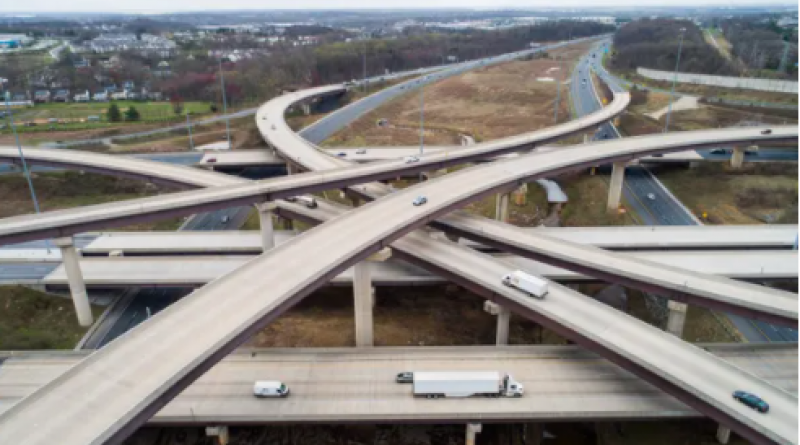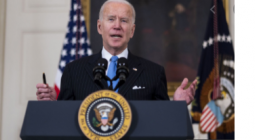Biden’s $2tn infrastructure plan aims to ‘finally address climate crisis as a nation'

President says new plan will allow ‘transformational progress’ by bolstering investments in clean energy and electric vehicles.
Joe Biden has said his new infrastructure plan will allow “transformational progress in our ability to tackle climate change” by bolstering investments in clean energy, electric vehicles and building homes resilient to threats posed by the climate crisis.
The $2tn plan will make “crumbling” American infrastructure more robust to extreme weather events, the US president said in a speech on Wednesday, while providing funds to “build a modern, resilient and fully clean grid”.
Biden said that tax incentives should allow “all Americans to afford clean electric vehicles” and workers will be able to “seize amazing opportunities in a clean energy future”.
Biden opened his White House term with a cavalcade of executive actions to begin the gargantuan task of shifting the US to net zero greenhouse gas emissions by 2050 and the new $2tn package, known as the American Jobs Plan, is the first indication of the scale of spending that will be required to reshape day-to-day life in order to avert disastrous climate change.
As well as huge investments in crumbling roads and bridges, the Biden plan takes aim at the emissions created by transport, currently the country’s largest source of planet-heating gases. There’s $80bn for Amtrak and freight rail, $85bn for public transit, $174bn to promote electric vehicles through various incentives, the electrification of school buses and 500,000 new plug-in recharging stations within the next decade. The federal government’s vehicle fleet will also be electrified.
Ports and airports will be upgraded, the plan states, while more than $200bn is proposed to build, modernize and fortify housing for low-income people affected by the storms, heatwaves and wildfires of growing intensity that are upending American lives and threatening billions, if not trillions, of dollars in ongoing damages. A further $100bn will be spent upgrading an electricity grid vulnerable to the sort of climate shocks that recently shook Texas, as well as aiding the transmission of a glut of new renewable energy. In all, 40% of this spending will be aimed at vulnerable communities of color.
The scale of the investment, even in the wake of the giant Covid relief bill, is striking. Biden made clear in his speech on Wednesday that this is the point when the US “finally address the climate crisis as a nation”, according to an administration official.
“There’s a lot to like in this plan, it’s excellent in almost every way,” said Julio Friedmann, who was a climate and energy adviser in Barack Obama’s administration and is now an energy researcher at Columbia University.
“This is a generational commitment and it can only be applauded. The $2tn is half the price tag of World War Two, it exceeds the scale of the New Deal, it’s wildly larger than the Marshall Plan – and appropriately so. This is the hardest thing we’ve ever done. People generally don’t understand how much construction and reduction is required.”
But even the administration’s allies concede further, longer-term spurs to remodel the economy and alter behavior will be required on top of this plan.
The package includes a major boost to clean energy research and development, as well as a proposal for a clean electricity standard – a mandate for utilities to phase out fossil fuels use across the grid to zero over the next 15 years that Friedmann said will be a “vital” element of eliminating planet-hearting emissions.
But these measures will, like the new spending, require congressional support that is far from guaranteed. Republicans have recoiled from Biden’s idea of raising corporate tax rates to help pay for the investments, with Mitch McConnell, the GOP’s Senate leader, calling the plan a “Trojan horse” for climate measures the party doesn’t support.
“In an ideal world this plan would be part of a set of policies to lower emissions but with American politics it’s not clear the rest of it will happen,” said David Popp, a climate policy expert at Syracuse University. “Infrastructure alone won’t get you to net zero emissions. The hope is that you build a green economy to the point where emissions reduction mandates become more doable.”
Progressives, meanwhile, have complained that Biden’s plan does not meet the scale of the climate crisis.
“Needs to be way bigger,” tweeted Alexandria Ocasio-Cortez, the Democratic representative from New York. Ocasio-Cortez and her allies back an alternative $10tn plan, called the Thrive Act, that proponents say would create 15m new jobs and cut emissions in half by the end of the decade. Rallies are set to be held across the US on Wednesday by climate activists who support this plan.
Communities of color, which often suffer the brunt of the climate crisis, helped elect Biden and “it’s time to make sure that our government delivers a real recovery that recognizes the harsh reality our communities continue to face on the ground,” according to Elizabeth Yeampierre, co-chair of the Climate Justice Alliance. “We’ve had enough excuses, enough delays.”
The Biden plan is a “big opening gambit, a big downpayment, but it’s not the totality required,” said Friedmann. “It focuses on what’s actionable quickly that yields big emissions abatement. I would like more too, but it’s easy to throw rocks from the outside. It’s a great start but, yes, we will ultimately need more. For the next 30 years, every week is infrastructure week.”
*Watch the video here
31 March 2021
The Guardian





